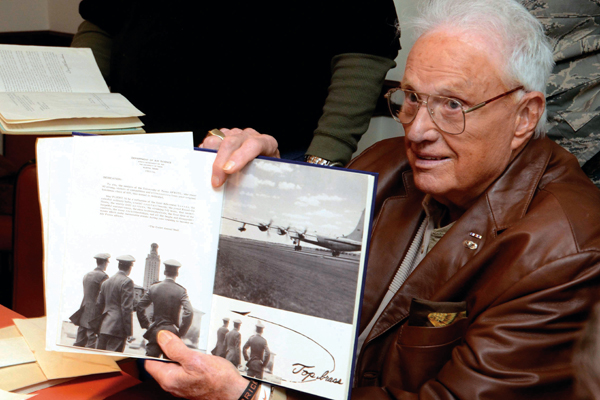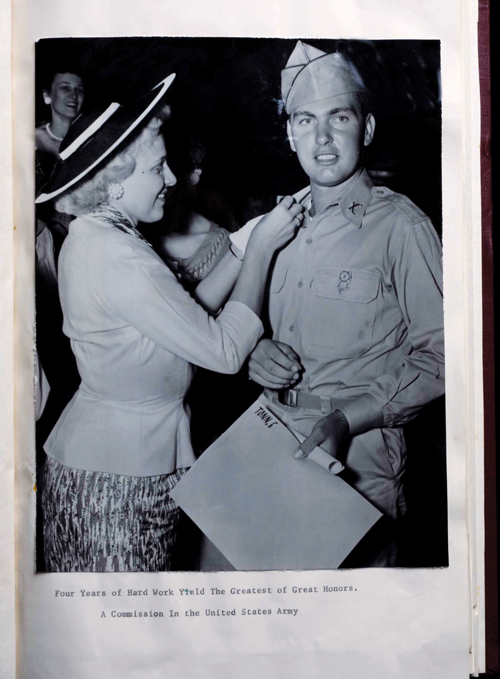Unearthed Time Capsule Fills Gaps in ROTC History After World War II
A glimpse of life at The University of Texas at Austin’s Reserve Officer Training Corps (ROTC) during the 1940s and ’50s was sealed within the building blocks of the former ROTC building for more than half a century.

Last fall, a crew of construction workers stumbled upon a 54-yearold time capsule in the cornerstone of Steindam Hall during demolition. About a year later, the ROTC and UT Veteran’s Committee gathered at the UT Club located within the Darrell K Royal-Texas Memorial Stadium to crack open the 4-by-12-inch copper box.
Frank Denius, a noted philanthropist and University of Texas at Austin alumnus (Business/Law, ’49), had the honors of revealing the contents before the committee. A decorated World War II veteran, Denius has a special connection to this piece of time.
Denius, who helped establish and fund the history department’s Normandy Scholars Program in 1990, proudly displayed a trove of photographs and well-preserved historical documents. Among the items was a 1957 ROTC textbook with a preface signed by former U.S. President Dwight D. Eisenhower.
Another interesting find was a letter from the 1954 Board of Regents detailing the plans to establish the original ROTC building, which was later renamed Russell A. Steindam Hall in 1972. Steindam was a University of Texas Army ROTC graduate who was posthumously awarded the Medal of Honor in 1970 for giving “the last full measure of devotion” in service of the nation in Vietnam.

As Denius tenderly sifted through the contents, he recognized some familiar faces in the glossy black and white photographs. Among the photographs were images of cadets at Fort Hood Summer Camp, B52 bombers and a Veterans Day march down Congress Avenue.
The time capsule also included a book detailing the history of the Naval ROTC from its inception in 1940 until 1957, a 1956 Air Force ROTC yearbook, a brief history of the Army ROTC following its establishment in 1947, and shoulder patches predating the university’s burnt-orange signature color.
“It was an honor to participate in the opening of the time ROTC capsule because it gave me a glimpse into the history and legacy of Air Force ROTC at The University of Texas,” says Col. Jeffrey Staha, chair and professor in the Department of Air Force Science. “The photographs and documents tell a story of service and tradition that today’s Air Force ROTC cadets strive to uphold. The time capsule and its contents also link the past with the present with the common link being a legacy of service to our nation and its defense.”
Lt. Col. Joseph Kopser, professor and chair of military science, says the capsule’s contents offer a rare glimpse back into a significant point in ROTC history.
“Opening the time capsule was a special experience for Texas Army ROTC,” Kopser says. “It reminds us of the rich legacy the program has shared with The University of Texas. From the early days of World War I when the campus mobilized to send volunteers to Europe, to the creation of Army ROTC in 1947, all the way through to the current conflict in Iraq and Afghanistan, The University of Texas has made continuous contributions to the defense of our nation.”

Capt. Dan Dixon, commanding officer and professor of naval science, says the contents of the time capsule were both fascinating and motivating. He was especially intrigued by a letter enclosed by a 1957 naval science professor.
“I was refreshed to know that the leadership principles and priorities for the professional development of our junior officers are still valid 54 years later,” Dixon says. “But I a lso feel challenged to carry on this legacy of excellence, dedication and service in everything we do here in the Department of Naval Science. The combination of a UT education and the junior officer development programs within our ROTC curricula has proven to be a perfect recipe for success for our future military leaders.”
Two days after the reveal, professors in all three ROTC programs, Army, Navy and Air Force Science, handed the items over to the Dolph Briscoe Center of American History for safekeeping. During the transfer of custody ceremony, the contents were presented to Thomas Hatfield, director of the center’s Military History Institute.
The items will later be housed in the new College of Liberal Arts building in 2013. Located on the East Mall, the 200,000 square-foot, glass and limestone structure will have customized classrooms to meet the needs of all three ROTC departments as they train future military leaders. Talks to place another time capsule in the new building are underway.
“Texas Army ROTC has played a major part in producing leaders of character for our state and our nation, and I’m proud to be a part of that tradition,” Kopser says. “I hope the next time capsule in the new COLA building can capture that same sense of pride.”
Both the Naval and Army ROTC presented the time capsule content at their annual alumni reunions on Nov. 5.
